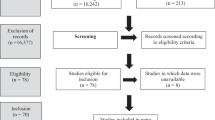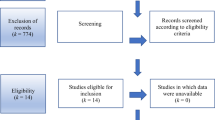Abstract
Mentor relationships have been identified as contributing to resilience in high-risk youth. Despite their promise, as well as a recent increase in volunteer mentoring programs, our understanding of mentor relationships rests on a base of observational data and very few empirical studies. Literature in several fields is reviewed and synthesized as it bears on mentoring. Although the literature converges on the importance of mentor relationships in shaping and protecting youth, many programmatic and conceptual issues remain unresolved. These issues constitute a compelling research agenda for this emerging field.
Similar content being viewed by others
References
Ainsworth, M. D. (1989). Attachment beyond infancy.American Psychologist, 44 709–716.
Alley, S. R., Blanton, J., & Feldman, R. E. (1979).Paraprofessionals in mental health. New York: Human Sciences Press.
Anderson, E. (1991). Neighborhood effects on teenage pregnancy. In C. Jencks & P. E. Peterson (Eds.),The urban underclass (pp. 375–398). Washington, DC: The Brookings Institution.
Barrera, M., Jr. (1981). Social support in the adjustment of pregnant adolescents: Assessment issues. In B. H. Gottlieb (Ed.),Social networks and social support (pp. 69–95). Beverly Hills, CA: Sage.
Blyth, D. A., Hill, J. P., & Smith, T. K. (1982). Early adolescents' significant others: Grade and gender difference in perceived relationships with familial and nonfamilial adults and young people.Journal of Youth and Adolescence, 11 425–450.
Blechman, E. A. (1992). Mentors for high-risk youth: From effective to bicultural competence.Journal of Clinical Child Psychology, 2 160–169.
Bolton, E. B. (1980). A conceptual analysis of the mentor relationship in the career development of women.Adult Education, 4 195–207.
Bronfenbrenner, U. (1988). Cited in Hamilton, S. F. (1990).Apprenticeship for adulthood. Cambridge, MA: Harvard University Press.
Burgoyne, N., & Kelly, J. G. (1991). Understanding mentoring among African-American youth: A collaborative approach. Paper presented at the Third Biennial Conference on Community Research and Action. Tempe, AZ.
Bryant, B. K. (1985). The neighborhood walk: Sources of support in middle childhood.Monographs of the Society for Research in Child Development, 50.
Caplan, G. (1964).Principles of preventive psychiatry. New York: Basic Books.
Carden, A. D. (1990). Mentoring and adult career development: The evolution of a theory.Counseling Psychologist, 18 275–299.
Cassel, J. C. (1976). The contribution of the social environment to host resistance.American Journal of Epidemiology, 104 107–123.
Coates, D. L. (1987). Gender differences in the structure and support characteristics of black adolescents' networks.Sex roles, 17 667–686.
Cowen, E. L. (1982). Help is where you find it: Four informal helping groups.American Psychologist, 37(4), 385–395.
Cowen, E. L., & Work, W. (1988). Resilient children psychological wellness, and primary prevention.American Journal of Community Psychology, 16 591–607.
Freedman, M. (1988).Partners in growth: Elder mentors and at risk youth. Philadelphia, PA: Public/Private Ventures.
Freedman, M. (1992).The kindness of strangers: Reflections on the mentoring movement. Philadelphia, PA: Public/Private Ventures.
Galbo, J. J. (1986). Adolescents' perceptions of significant adults: Implications for the family and the school and youth serving agencies.Children and Youth Services Review, 8 35–51.
Garbarino, J., Burston, N., Raber, S., Russell, R., & Crouter, A. (1978). The social maps of children approaching adolescence: Studying the ecology of youth development.Journal of Youth and Adolescence, 7 417–428.
Garmezy, N. (1983). Stressors of childhood. In N. Garmezy & M. Rutter (Eds.),Stress, coping, and development in children (pp. 73–84). New York: McGraw Hill.
Garmezy, N. (1985). Stress resistant children: The search for protective factors. In J. E. Stevenson (Ed.),Recent research in developmental psychopathology (pp. 213–233). Oxford: Pergamon.
Garmezy, N., & Neuchterlein, K. (1972). Invulnerable children: The fact and fiction of competence and disadvantage.American Journal of Orthopsychiatry, 42 328–329.
Hamilton, S. F. (1990).Apprenticeship for adulthood. Cambridge, MA: Harvard University press.
Healy, C. C., & Welchert, A. J. (1990). Mentoring relations: A definition to advance research and practice.Educational researcher, 12 17–21.
Kram, K. E. (1985).Mentoring at work: Developmental relationships in organizational life. Glenview, IL: Scott Foresman.
Langner, T. S., & Michael, S. T. (1963).Life stress and mental health. New York: Free Press.
Lefkowitz, B. (1986).Tough change: Growing up on your own in America. New York: Free Press.
Levinson, D., Darrow, C., Klein, E., Levinson, M., & McKee, B. (1978).The seasons of a man's life. New York: Knopf.
Luthar, S.E., & Zigler, E. (1991). Vulnerability and competence: A review of research on resilience in childhood.American Journal of Orthopsychiatry, 61 6–22.
Masten, A. S., & Garmezy, N. (1985). Risk, vulnerability, and protective factors in developmental psychopathology. In B. B. Lahey & A. E. Kazdin (Eds.),Advances in Child-Clinical Psychology (pp. 1–52). New York: Plenum.
Maton, K. I. (1990). Meaningful involvement in instrumental activity and well-being: Studies of older adolescent and at-risk urban teenagers.American Journal of Community Psychology, 18(2), 297–320.
Merriam, S. (1983). Mentors and proteges: A critical review of the literature.Adult Education Quarterly, 33 161–175.
Rappaport, J. (1977).Community psychology: Values, research, and action. New York: Holt, Rinehart, Winston.
Rhodes, J. E. (In press). Alternative schools for pregnant teens: How mentoring programs can ease the transitions.Prevention in human services.
Rhodes, J. E., Ebert, L., & Fischer, K. (In press). Natural mentors: An undiscovered resource in the social networks of African-American adolescent mothers.American Journal of Community Psychology.
Rhodes, J. E., Reyes, O., & Jason, L. A. (In press). Prevention of behavior disorders in children. In R. Morris & T. Kratochwell (Eds.),Handbook of psychotherapy with children. New York: Pergamon Press.
Rhodes, J. E., Reyes, O., & Jason, L. A. (In press). Prevention of behavior disorders in children. In R. Morris & T. Kratochwell (Eds.),Handbook of psychotherapy with children. New York: Pergamon Press.
Rutter, M. (1979). Protective factors in children's responses to stress and disadvantage. In M. W. Kent, & J. E. Rolf (Eds.),Primary prevention of psychopathology: Vol. 3. Social competence in children (pp. 49–74). Hanover, NH: University Press of New England.
Rutter, M. (1987). Psychosocial resilience and protective mechanisms.American Journal of Orthopsychiatry, 57 57–72.
Rutter, M., & Giller, H. (1983).Juvenile delinquency: Trends and Perspectives. New York: Guilford Press.
Scott, R. (1987). Tender memories. In K. Scott, C. Muhanji, E. High (1987),Tight Spaces San Francisco: Spinsters/Aunt Lute.
Vallence, T. R., & D'Augelli, A. R. (1982). The helping community: Characteristics of natural helpers.American Journal of Community Psychology, 10 197–205.
Werner, E. E. (1990). Protective factors and individual resilience. In S. J. Meisels & J. P Shonkoff (Eds.),Handbook of early intervention (pp. 97–116). New York: Cambridge University Press.
Werner, E. E. (1987). Cited in Goleman, (1987, October). Thriving despite hardship: Key childhood traits identified.The New York Times, P. C1, 11.
Werner, E. E., & Smith, R. S. (1982).Vulnerable but invincible: A study of resilient children. New York: McGraw-Hill.
White, L. L., Kaban, B. T., & Attanuci, J. S. (1979).The origins of human competence: Final report of the Harvard Preschool Project. Lexington, MA: D.C. Heath.
Williams, T. M., & Kornblum, W. (1985).Growing up poor. Lexington, Mass: Lexington Books.
Author information
Authors and Affiliations
Rights and permissions
About this article
Cite this article
Rhodes, J.E. Older and wiser: Mentoring relationships in childhood and adolescence. J Primary Prevent 14, 187–196 (1994). https://doi.org/10.1007/BF01324592
Issue Date:
DOI: https://doi.org/10.1007/BF01324592




